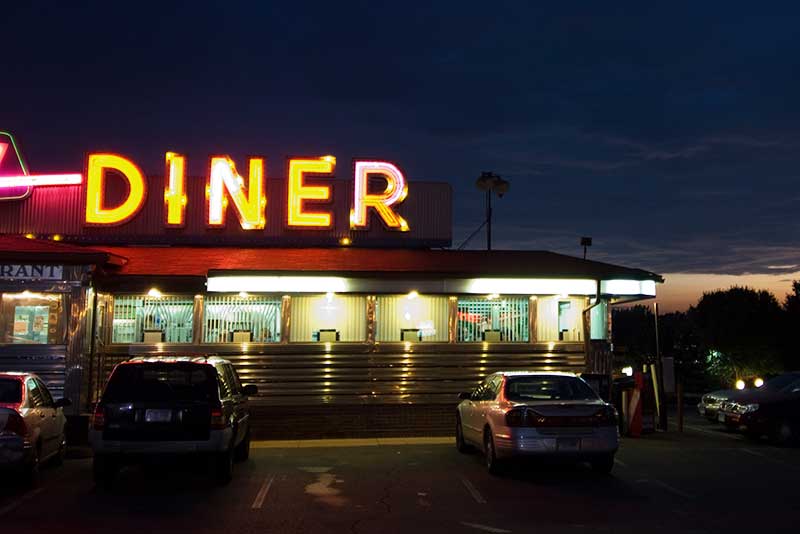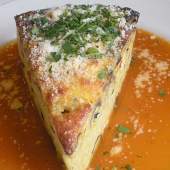The Diner

“Surely you know what a blue-plate is, man? They shove the whole meal at you under your nose, already dished up on your plate — roast turkey, cranberry sauce, sausages and carrots and French fried. I can't bear French fried but there's no pick and choose with a blue-plate."
"No pick and choose?”
"You eat what you're given. That's democracy, man."
— Graham Greene, Our Man in Havana
“Opening up, letting the day in
Over a cup, we’ll say ‘Hello, how ya been?’
Looking around, seeing the same things –
‘Hello, how ya been? Thank you, come again!’
Some things never change…
Hurry up, fill the coffee cup,
And then in a while, take a breath…”
— Waitress the Musical
Is there anything more quintessentially American than a good old-fashioned diner? A place that is always open, 24 hours a day, with a friendly waitress who makes small talk, keeps your coffee cup full, and nudges you toward her favorite things on the menu?
In this day of food trucks all over our city streets, it’s telling that the original diner was not a stationary brick-and-mortar restaurant, but mobile — traveling to wherever hungry people wanted to eat.
For this idea, we can thank a teenaged typesetter, Walter Scott, for a brainstorm he had sometime in 1872 in his hometown of Providence, Rhode Island. One evening while working for the Providence Journal, he noticed that, as restaurants in that era tended to close right after the dinner hour, there was nowhere for anyone who worked the night shift to get a meal. To make some extra money, Scott began selling coffee and sandwiches to his coworkers, later toting his wares to nearby establishments that stayed open all night. This service soon became so popular – and lucrative – that the enterprising Scott quit his day job, put his hard-earned profits toward a horse and covered wagon, stocked it with food and beverages, and stationed it on the main drag to cater to area overnighters. Not surprisingly, he did a booming business. This remained a strictly walk-up, “to-go” concern, until…
American Eagle Cafe #200, the first lunch car built by Worcester Lunch Car Company. Photo by E.B. Luce, 1907.
…An innovator named Thomas Buckley in Worcester, Massachusetts, positing that mobile food wagon patrons ought to be able to sit down for their meal, in 1887 designed what became popularly known as a “lunch car” or “owl wagon” which was either designed to resemble – or actually was – a repurposed train car, which could still be easily transported from one location to another as demand dictated. As time went on, the car’s wheels gradually got smaller, its counters got wider, the number of stools increased, its cooking appliances got bigger, and its amenities eventually expanded to booths, window curtains, and tiled restrooms.
In the logical next step in this progression, in 1913 an entrepreneur named Jerry O’Mahoney, evidently figuring (with apologies to Field of Dreams) that “if you build it, they will come,” opened the first diner that didn’t move. He designed a stylish pre-fabricated structure that could be shipped in pieces anywhere in the country and assembled to his specifications on the other end. As was the case with thousands of industries, the Great Depression posed big challenges for O’Mahoney’s expansion plans, but overall, it was ideal for the period, as it was a way for someone to acquire his or her own small business with little to no risk (because everyone needs to eat, right?). By the 1950s, O’Mahoney’s companies oversaw more than 6,000 branded diners all across America.
Of course, his franchises inspired plenty of local competition, so there was eventually at least one diner of some sort in every city and town, touting “homecooked” meals at bargain prices. These eateries became important communal gathering places, and have been featured in many movies, plays, and television shows, including Sullivan’s Travels, Pulp Fiction, Five Easy Pieces (where Jack Nicholson famously told a waitress exactly what she could do with a chicken), Twin Peaks, Broadway’s Waitress the Musical, and, well…Diner, to name just a few. And of course, in art, where the late-night diner, its counterman, and habitués were immortalized in Edward Hopper’s “Nighthawks.” Also, where a young boy, a knapsack at his feet, converses with a friendly cop and the amused proprietor of a lunch counter in Norman Rockwell’s “The Runaway.”
What was served at these establishments? Comfort food, of course — the more affordable the better. Each day, there was traditionally a “blue-plate special” – whatever complete meal the kitchen happened to be pushing (no substitutions allowed!), served on a sectioned ceramic (initially blue) plate. The term appears to have been coined in 1892 by Fred Harvey for his famous Harvey House restaurant chain. The repast could include anything from meatloaf to roast turkey to chicken to pot roast, with a starch (potatoes or rice), one or two cooked vegetables, perhaps a roll, and dessert – pie, cake, or perhaps pudding. In its heyday in the 1920s and ’30s, a blue-plate special could be had for 25 cents, and was advertised as “a square [meal] for two bits.” A stout ham-and-eggs breakfast was popular, too – or, for the regulars stopping by on their way to work, a 10-cent cup of coffee and a “sinker” (a donut to be dunked in coffee).
It was during this golden era that the Chicago institution Lou Mitchell's was founded, in 1923. 94 years later, this authentic retro diner is still going strong in the downtown Loop area. The prices may not be quite what they were back then, but your taste buds won’t notice!
After a brief revival in the late 1970s, today very few of the original “train car” diners survive; most have been replaced in the restaurant ecosystem by generic fast food places. It’s hard to imagine any of them truly replicating the experience of those long-ago temples of chrome and Formica – those homey diners where, according to Sullivan’s Travels, “a cup of coffee and a sinker will fix [you] up fine.”





